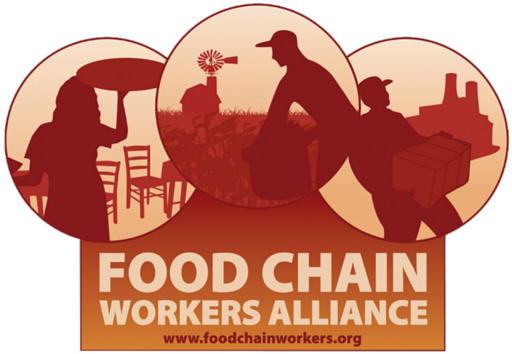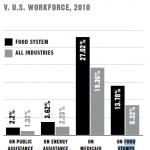Food and Farm Bill 2012: Agriculture Reform, Food, and Jobs Act of 2012
Every five years members of Congress in both the House of Representatives and the Senate make amendments, or changes, to the Farm Bill. After voting on the amendments, the Farm Bill is sent to the President to sign. This year members of Congress need to make changes to the 2008 Farm Bill before the Bill’s expiration date on September 30th.
Historically, the first Farm Bill was called the Agricultural Adjustment Act of 1933. It was created during the Great Depression to assist American farmers in the midst of drastically falling farm prices and the many Americans who were not able to buy food. The Act allowed the US government to buy the food that was grown by farmers which was then given to the people through government-supported food assistance programs.
Today the Senate-proposed Farm Bill is over 1000* pages containing 15 different titles or areas. The titles are Nutrition, Commodities, Energy (added in 2008), Horticulture and Organic Agriculture, Livestock, Conservation, Trade, Credit, Rural Development, Research, Forestry, Crop Insurance, Commodity Futures, Trade and Taxes, and Miscellaneous. These titles make up lots of separate parts that are passed as a single bill. The total cost of the proposed Farm Bill is about half a trillion dollars over the course of 5 years, with Senate-proposed cuts reaching $23 billion to the 2008 Farm Bill. The greatest proportion of the Farm Bill is used for food assistance programs including Women, Infants and Children (WIC) and the Supplemental Nutrition Assistance Program (SNAP, formerly known as Food Stamps).
Despite the largest portion of funding directed towards low-income consumers through nutrition assistance programs, corporations and large-crop agribusinesses have been and continue to be the Farm Bill’s biggest winners.
The Process
On June 21st, 2012, the Senate passed an agreed-upon version of their changes to the Farm Bill, celebrating the bipartisan effort. The House of Representatives is currently discussing changes and will make final amendments by July 11th. House negotiations are important for FCWA members and allies as House Republicans are calling for even greater budget cuts than the Senate version. These cuts include cuts to SNAP benefits (formerly called food stamps), which will disproportionately impact low-income communities and food workers. [more details below]
Ideally, after the House’s decision, individuals from the Senate and House will sit down together to negotiate their accepted versions of the Farm Bill to come up with an agreed upon draft. The draft will then go back for debate and voting among each institutions’ respective legislators. Once a copy is agreed upon it will go to the President for signing. The due date is September 30, 2012. If an agreed-upon version of the Farm Bill is not in place ,then provisions for an extension will be made.
Why is it important for consumers and food workers?
The largest proportion of funds in the Farm Bill’s Nutrition title go towards the Supplemental Nutrition Program (SNAP). SNAP, formerly known as Food Stamps, provides low-income families with supplemental income to meet their household food needs. Last year 46 million, or 1 in 7 Americans, participated in SNAP. Food chain workers are food consumers. As highlighted in our recent report, The Hands that Feed Us, food system workers use SNAP at a rate double that of the US workforce. Therefore, a large proportion of SNAP participants work in the food system.
This year, both the Senate and House of Representative changes to the Farm Bill include proposals for significant funding cuts to SNAP. These cuts from the Senate amount to $4.5 billion, over a ten-year period ,despite Sen. Kirsten Gillibrand’s (D-NY) efforts. Proposed cuts to SNAP from the House reach an even greater $33 billion, and will be voted on on[1] July 11th. As Lorette Picciano, executive director of the Rural Coalition/Coalición Rural, helped to clarify, if these proposed cuts are accepted, fewer reductions would be necessary to the Department of Defense’s budget, while still meeting the 4% deficit-reduction goal proposed last year. This may explain the motivation behind the largely Republican-driven SNAP budget cuts, while highlighting the need for monitoring the effects of such non-defense cuts by the Office of Management and Budget.
Proposed funding cuts to the Supplemental Nutrition Assistance Program (SNAP) from both the Senate and the House may threaten the health and well-being of food chain and other low-income workers and their families. Increased participation and spending in SNAP coincide with the economic downturn, suggesting many of us need SNAP now more than ever.
Not surprisingly, corporate interests that prevail in agriculture subsidies and crop insurance protections also prevail in the nutrition title of the Farm Bill. A recent report, by public health lawyer Michele Simon, found that intense lobbying efforts on the part of major corporations have limited more healthful changes to SNAP and that SNAP favors corporations such as Coca-Cola, JP Morgan Chase, and WalMart. With increased rates of nutrition-related diseases among low-income Americans, these findings raise the question of how effectively SNAP, a critical safety net to addressing food security and hunger, is also able to support the public health and well-being of low-income Americans. Is it enough to simply feed, without provisions also for health?
Why is it important for workers?
Although the Farm Bill does not deal with the treatment of workers in the fields, factories, grocery stores, or restaurants, there are a few provisions in the 2012 Farm Bill that may positively impact socially disadvantaged farmers, veteran farmers, beginning farmers, and rural communities. Despite the majority of subsidies and benefits going to large agribusinesses, activists’ voices are being heard as amendments to the Farm Bill respond to concerns around the illusive “small farmer”, organic food subsidies and protections, diversifying and relocalizing markets, and extending credit to American Indian, Latino/a, African American, and Asian American farmers, ranchers, and former farmworkers! As evident with the failed RAISE Act amendment by Sen. Rubio (R-FL), continued organizing efforts are necessary to ensure accountability to workers and consumers as negotiations continue, protecting against these sorts of last-minute anti-labor moves, as well as ensuring existing programs and grants are supported in light of the House’s proposed budget cuts.
Socially Disadvantaged (including Veteran) Farmers
Outreach and Technical Assistance for Socially Disadvantaged Farmers and Ranchers Program- Section 2501, provides grants to Land Grant Institutions, Native American Tribal Governments and organizations, Latino-Serving Institutions, State Controlled Institutions of Higher Education, and community-based organizations and non-profits that work with marginalized farmers. These funds are provided to and assist farmers in owning and operating farms and participating in agriculture and USDA programs. Grants are awarded annually, averaging $254,533. Applications and additional information may be found here.
Although funding was increased substantially in the 2008 Farm Bill, and extended to veteran farmers in the 2012 Senate-passed version, this year’s Farm Bill has slashed the 2501 program from $75 million/4 years to $25 million/5 years despite efforts by Sen. Udall (D-NM). These cuts would drastically undermine the grassroots gains made in 2008 which provided a small means for pushing-back against giant agribusiness farm consolidation and the historic institutional exclusion of farmers of color. Examples of past grant recipients may be found here. Organizing efforts are continuing as the Farm Bill moves into the House, yet a more positive receptive response is unlikely.
Beginning Farmer Development Program (BFRDP)
BFRDP is a grant awarded through the National Institute of Food and Agriculture (NIFA) which funds education, extension, outreach, and technical assistance programs for beginning farmers and ranchers. An important part of the BFRDP is the use of “land link” programs that work to connect retiring and new farmers through training, mentoring, and apprenticeship programs. Topics covered by these trainings have included production practices, conservation, risk management, diversification and marketing strategies, environmental compliance, credit management, etc.
Twenty-five percent of these funds are set aside for socially disadvantaged farmers and ranchers, veterans, racial minorities, immigrants, women farmers and ranchers, and importantly for FCWA members, farmworkers who want to become farmers! These grants last for 3 years at a maximum of $250,000/year. Application information may be found here.
Sustained Organizing Efforts
Continued organizing is necessary as the Farm Bill debate moves into the House. The few programs for socially disadvantaged farmers must be protected and extended to 2008 levels. Restoration of SNAP to the 2008 level is also of major concern for consumer/worker advocacy groups.
Several failed amendments made to the 2012 Farm Bill give reason to worry for members of the FCWA and other social justice activist groups. These include the RAISE Act proposed by Sen. Rubio (R-Fla) which would permit pay raises to workers without employers receiving permission from unions. This is seen as an attempt to further break labor unions, allowing for employers to cut insurance and pension programs. This amendment failed by a slim margin of 45-54. Another failed amendment (46-53), proposed by Sen. Jeff Sessions (R-Ala), would require that every person in a household show proof of citizenship before anyone in the home receives SNAP, furthering the demoralizing attack against undocumented families, many of whom are workers and influential members of the US food chain. It is unlikely that the failure of these amendments to pass will deter organizing efforts by supporters, which means we must continue fighting against such anti-labor/anti-immigrant efforts.
Another failed amendment which greatly affects workers and consumers was proposed by Sen. Sanders (I-VT), which promoted ‘a consumer’s right to know about genetically engineered food.’ This amendment would have allowed states to make decisions on GMO labeling. This amendment was turned down in a vote of (26-73).
Despite efforts by the Institute for Agriculture and Trade Policy, the Seattle City Council, and the National League of Cities to support fair working conditions for “farmers, workers, and eaters within the food system” through the necessary creation of “fair wages” and “more just communities” (IATP) focusing on protecting the health of “farmers, farm workers, and food system workers from chemicals and hazardous working conditions,” the concerns of farmworkers and other food chain workers are not seriously considered within the current Farm Bill. Efforts are being made to extend OSHA worker protections to farmworkers, as the current EPA Worker Protection Standard of the Federal Insecticide, Fungicide and Rodenticide Act are not strict enough.
Although the 2012 Farm Bill is an extremely important piece of legislation, it is only the beginning. Especially in light of the federal deficit,and proposed solutions, workers, consumers, and advocacy groups must continue the struggle to protect and better reform existing programs within the Farm Bill, like SNAP and 2501, but[2] also beyond what is currently on the table. A sustained effort is necessary to extend protections to farmworkers,and other workers along the food chain. To ensure a more socially just and environmentally sustainable food system, we must fight to protect the few existing provisions for low-income consumers, environmentally mindful farmers, socially disadvantaged farmers and ranchers and farmers/ranchers of color while pushing for further legislation that protects and improves the rights of workers along the food chain!
How to Take Action and Stay Informed!
You can take action by staying informed, signing up for action alerts on the Farm Bill, joining a Farm Bill listening session, writing or calling your Congress representatives, and connecting with actions locally!
Food and Water Watch National Petition
Northwest Farm Bill Action Group
National Sustainable Agriculture Coalition– Farming for the Future Farm Bill platform
Community Food Security Coalition
[3] Our Food System is Forked Up: Why the Farm Bill Matters
Enough to Eat Food Assistance and the Farm Bill
Marion Nestle’s Farm Bill resources
Institute for Agriculture and Trade Policy– Farm Bill Series



